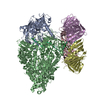[English] 日本語
 Yorodumi
Yorodumi- PDB-8ppu: Pyrococcus abyssi DNA polymerase D (PolD) in its editing mode bou... -
+ Open data
Open data
- Basic information
Basic information
| Entry | Database: PDB / ID: 8ppu | |||||||||||||||||||||||||||||||||||||||||||||||||||||||||||||||
|---|---|---|---|---|---|---|---|---|---|---|---|---|---|---|---|---|---|---|---|---|---|---|---|---|---|---|---|---|---|---|---|---|---|---|---|---|---|---|---|---|---|---|---|---|---|---|---|---|---|---|---|---|---|---|---|---|---|---|---|---|---|---|---|---|
| Title | Pyrococcus abyssi DNA polymerase D (PolD) in its editing mode bound to a primer/template substrate containing three consecutive mismatches | |||||||||||||||||||||||||||||||||||||||||||||||||||||||||||||||
 Components Components |
| |||||||||||||||||||||||||||||||||||||||||||||||||||||||||||||||
 Keywords Keywords | DNA BINDING PROTEIN / Polymerase / DNA / Replication / PolD / Archaea / Editing / Proofreading / Exonuclease / Nuclease | |||||||||||||||||||||||||||||||||||||||||||||||||||||||||||||||
| Function / homology |  Function and homology information Function and homology informationexodeoxyribonuclease I / DNA polymerase complex / single-stranded DNA 3'-5' DNA exonuclease activity / DNA catabolic process / DNA strand elongation involved in DNA replication / DNA polymerase processivity factor activity / leading strand elongation / regulation of DNA replication / DNA-directed DNA polymerase / DNA-directed DNA polymerase activity / DNA binding Similarity search - Function | |||||||||||||||||||||||||||||||||||||||||||||||||||||||||||||||
| Biological species |   Pyrococcus abyssi GE5 (archaea) Pyrococcus abyssi GE5 (archaea) | |||||||||||||||||||||||||||||||||||||||||||||||||||||||||||||||
| Method | ELECTRON MICROSCOPY / single particle reconstruction / cryo EM / Resolution: 3.02 Å | |||||||||||||||||||||||||||||||||||||||||||||||||||||||||||||||
 Authors Authors | Betancurt-Anzola, L. / Martinez-Carranza, M. / Zatopek, K.M. / Gardner, A.F. / Sauguet, L. | |||||||||||||||||||||||||||||||||||||||||||||||||||||||||||||||
| Funding support |  France, 1items France, 1items
| |||||||||||||||||||||||||||||||||||||||||||||||||||||||||||||||
 Citation Citation |  Journal: Nat Commun / Year: 2023 Journal: Nat Commun / Year: 2023Title: Molecular basis for proofreading by the unique exonuclease domain of Family-D DNA polymerases. Authors: Leonardo Betancurt-Anzola / Markel Martínez-Carranza / Marc Delarue / Kelly M Zatopek / Andrew F Gardner / Ludovic Sauguet /   Abstract: Replicative DNA polymerases duplicate entire genomes at high fidelity. This feature is shared among the three domains of life and is facilitated by their dual polymerase and exonuclease activities. ...Replicative DNA polymerases duplicate entire genomes at high fidelity. This feature is shared among the three domains of life and is facilitated by their dual polymerase and exonuclease activities. Family D replicative DNA polymerases (PolD), found exclusively in Archaea, contain an unusual RNA polymerase-like catalytic core, and a unique Mre11-like proofreading active site. Here, we present cryo-EM structures of PolD trapped in a proofreading mode, revealing an unanticipated correction mechanism that extends the repertoire of protein domains known to be involved in DNA proofreading. Based on our experimental structures, mutants of PolD were designed and their contribution to mismatch bypass and exonuclease kinetics was determined. This study sheds light on the convergent evolution of structurally distinct families of DNA polymerases, and the domain acquisition and exchange mechanism that occurred during the evolution of the replisome in the three domains of life. | |||||||||||||||||||||||||||||||||||||||||||||||||||||||||||||||
| History |
|
- Structure visualization
Structure visualization
| Structure viewer | Molecule:  Molmil Molmil Jmol/JSmol Jmol/JSmol |
|---|
- Downloads & links
Downloads & links
- Download
Download
| PDBx/mmCIF format |  8ppu.cif.gz 8ppu.cif.gz | 506.9 KB | Display |  PDBx/mmCIF format PDBx/mmCIF format |
|---|---|---|---|---|
| PDB format |  pdb8ppu.ent.gz pdb8ppu.ent.gz | 397 KB | Display |  PDB format PDB format |
| PDBx/mmJSON format |  8ppu.json.gz 8ppu.json.gz | Tree view |  PDBx/mmJSON format PDBx/mmJSON format | |
| Others |  Other downloads Other downloads |
-Validation report
| Summary document |  8ppu_validation.pdf.gz 8ppu_validation.pdf.gz | 1.4 MB | Display |  wwPDB validaton report wwPDB validaton report |
|---|---|---|---|---|
| Full document |  8ppu_full_validation.pdf.gz 8ppu_full_validation.pdf.gz | 1.4 MB | Display | |
| Data in XML |  8ppu_validation.xml.gz 8ppu_validation.xml.gz | 78.3 KB | Display | |
| Data in CIF |  8ppu_validation.cif.gz 8ppu_validation.cif.gz | 120.7 KB | Display | |
| Arichive directory |  https://data.pdbj.org/pub/pdb/validation_reports/pp/8ppu https://data.pdbj.org/pub/pdb/validation_reports/pp/8ppu ftp://data.pdbj.org/pub/pdb/validation_reports/pp/8ppu ftp://data.pdbj.org/pub/pdb/validation_reports/pp/8ppu | HTTPS FTP |
-Related structure data
| Related structure data |  17816MC  8pptC  8ppvC M: map data used to model this data C: citing same article ( |
|---|---|
| Similar structure data | Similarity search - Function & homology  F&H Search F&H Search |
- Links
Links
- Assembly
Assembly
| Deposited unit | 
|
|---|---|
| 1 |
|
- Components
Components
-DNA chain , 2 types, 2 molecules PT
| #1: DNA chain | Mass: 6512.451 Da / Num. of mol.: 1 / Source method: obtained synthetically / Source: (synth.)   Pyrococcus abyssi GE5 (archaea) Pyrococcus abyssi GE5 (archaea) |
|---|---|
| #2: DNA chain | Mass: 7717.934 Da / Num. of mol.: 1 / Source method: obtained synthetically / Source: (synth.)   Pyrococcus abyssi GE5 (archaea) Pyrococcus abyssi GE5 (archaea) |
-DNA polymerase ... , 2 types, 4 molecules ACDE
| #3: Protein | Mass: 74009.742 Da / Num. of mol.: 1 / Mutation: H451A Source method: isolated from a genetically manipulated source Details: DP1 subunit / Source: (gene. exp.)   Pyrococcus abyssi GE5 (archaea) / Gene: polB / Production host: Pyrococcus abyssi GE5 (archaea) / Gene: polB / Production host:  |
|---|---|
| #4: Protein | Mass: 29471.764 Da / Num. of mol.: 3 Source method: isolated from a genetically manipulated source Details: PCNA / Source: (gene. exp.)   Pyrococcus abyssi GE5 (archaea) / Gene: pcn / Production host: Pyrococcus abyssi GE5 (archaea) / Gene: pcn / Production host:  |
-Protein , 1 types, 1 molecules B
| #5: Protein | Mass: 144418.969 Da / Num. of mol.: 1 Source method: isolated from a genetically manipulated source Source: (gene. exp.)   Pyrococcus abyssi GE5 (archaea) / Production host: Pyrococcus abyssi GE5 (archaea) / Production host:  |
|---|
-Non-polymers , 2 types, 6 molecules 


| #6: Chemical | | #7: Chemical | |
|---|
-Details
| Has protein modification | Y |
|---|
-Experimental details
-Experiment
| Experiment | Method: ELECTRON MICROSCOPY |
|---|---|
| EM experiment | Aggregation state: PARTICLE / 3D reconstruction method: single particle reconstruction |
- Sample preparation
Sample preparation
| Component | Name: Binary complex of PolD bound to PCNA and a primer/template duplex containing three consecutive mismatches Type: COMPLEX / Entity ID: #3, #5, #4, #1-#2 / Source: RECOMBINANT |
|---|---|
| Source (natural) | Organism:   Pyrococcus abyssi GE5 (archaea) Pyrococcus abyssi GE5 (archaea) |
| Source (recombinant) | Organism:  |
| Buffer solution | pH: 8 |
| Specimen | Embedding applied: NO / Shadowing applied: NO / Staining applied: NO / Vitrification applied: YES |
| Vitrification | Cryogen name: ETHANE |
- Electron microscopy imaging
Electron microscopy imaging
| Experimental equipment |  Model: Titan Krios / Image courtesy: FEI Company |
|---|---|
| Microscopy | Model: TFS KRIOS |
| Electron gun | Electron source:  FIELD EMISSION GUN / Accelerating voltage: 300 kV / Illumination mode: FLOOD BEAM FIELD EMISSION GUN / Accelerating voltage: 300 kV / Illumination mode: FLOOD BEAM |
| Electron lens | Mode: BRIGHT FIELD / Nominal defocus max: 3000 nm / Nominal defocus min: 1000 nm |
| Image recording | Electron dose: 40 e/Å2 / Film or detector model: GATAN K3 BIOQUANTUM (6k x 4k) |
- Processing
Processing
| EM software | Name: PHENIX / Category: model refinement | ||||||||||||||||||||||||
|---|---|---|---|---|---|---|---|---|---|---|---|---|---|---|---|---|---|---|---|---|---|---|---|---|---|
| CTF correction | Type: PHASE FLIPPING AND AMPLITUDE CORRECTION | ||||||||||||||||||||||||
| 3D reconstruction | Resolution: 3.02 Å / Resolution method: FSC 0.143 CUT-OFF / Num. of particles: 306575 / Symmetry type: POINT | ||||||||||||||||||||||||
| Refine LS restraints |
|
 Movie
Movie Controller
Controller




 PDBj
PDBj









































